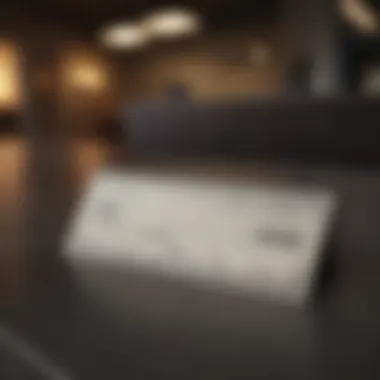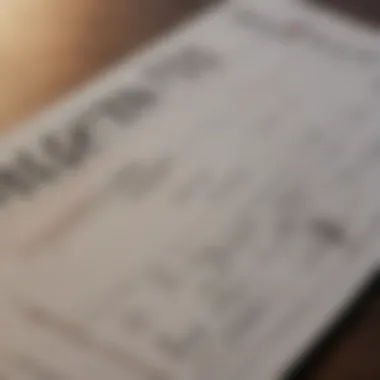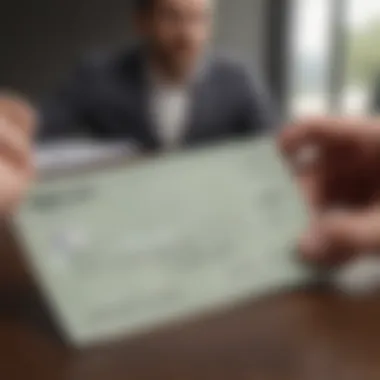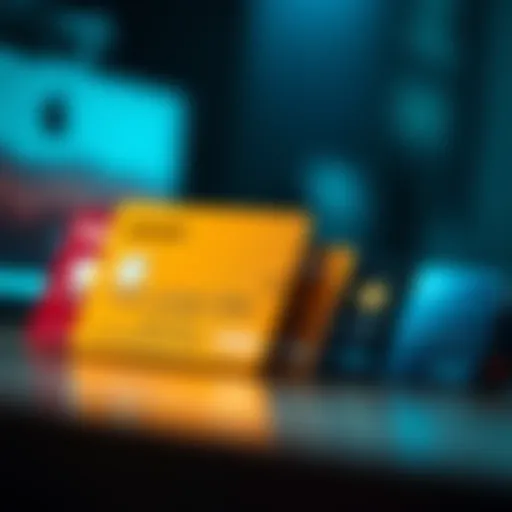Spotting Counterfeit Checks: Essential Techniques


Intro
In today’s fast-paced world, where technology runs the show and convenience is king, it’s vital to have a keen eye for what constitutes a legitimate check. Fraudulent checks are popping up left and right, often disguised as trustworthy documents. Young professionals, students, and small business owners find themselves in the sights of such scams more than they might think. So, knowing how to spot a fake can save time, money, and needless stress.
Understanding Financial Concepts
In order to understand how to pinpoint a fake check, one must first get a handle on some essential financial concepts. Without grasping the basics, anyone can easily fall into the trap of a counterfeit check without even realizing it.
Definitions of Key Terms
Check: A written order directing a bank to pay money from the author's account to another person.
Counterfeit: An imitation of a document or currency with the intent to deceive.
Fraud: Wrongful or criminal deception intended to result in financial or personal gain.
Understanding these terms can provide clarity. When it comes down to checking those legitimacy characteristics, familiarity with these definitions is key.
Importance of Financial Literacy
Being financially literate empowers individuals to make informed decisions. It helps to differentiate between legitimate financial documents and those that might lead to financial loss. Research shows that many check frauds can go unnoticed because there’s a lack of understanding surrounding correct check practices.
Think about it: A well-informed individual is less likely to be affected by scams. They can identify inconsistencies and ask the right questions right when money is on the line. This goes beyond just checks; the understanding of overall financial health can foster lasting independence.
"Knowledge is power; know what you are handling to keep your wallet safe."
Key Features of a Check
When presented with a check, take a moment to check for the following signs:
- Paper Quality: High-quality checks feel distinct. They should have a slightly textured surface.
- Microprinting: Look closely at specific areas. A legitimate check will often have tiny text that is hard to replicate.
- Watermarks: Many checks come with watermarks that can’t be easily imitated. If it doesn’t have one, it might be suspect.
- Routing and Account Numbers: Cross-reference these numbers with a bank's list to ensure they match with what's valid. If there’s an error, then it’s just not right.
Verifying Authenticity
When in doubt, validation is key. Modern banking allows you to do some checks almost instantly. Here’s how to approach it:
- Contact the Bank: Using the phone number from the bank's official website, not what’s on the check, ask if the check is genuine.
- Use Digital Tools: Many apps can scan the checks and provide information about their authenticity.
- Look for Inline Features: Check for colored fibers in the paper that are only present in genuine checks.
Remember, if something feels off, trust your gut. Inform yourself and take additional steps to verify before cashing in.
This leads into further aspects of fraud awareness, making sure you know about the context of your financial dealings and how to safeguard your wealth against deceit.
Stay tuned for more detailed insights, particularly on spotting the subtle signs that might indicate a check is more than just a slip of paper – it could be a ticket to a financial headache!
Next Steps
In the following sections, we will dive deeper into understanding the nuances of checks and the tactics employed by fraudsters, so you can navigate this financial landscape with confidence.
Understanding Checks and Their Functionality
Understanding how checks work is pivotal when it comes to spotting forgeries. Checks are more than mere pieces of paper; they serve as formal instructions to a bank, allowing funds to be transferred from one party to another. Knowing their functionality is the first step in preventing financial mishaps.
Recognizing the role checks play in personal and business transactions helps individuals and small business owners appreciate their significance. Essentially, checks are a tool of assurance, providing security in financial dealings. The importance of checks becomes even clearer when you consider the risks associated with mishandling or misidentifying them. Therefore, learning about their functionality helps to navigate the complex landscape of finance safely.
The Basics of Checks
Checks can be a bit tricky if you're not well-acquainted with their anatomy. A typical check includes several key details: the date, the payee's name, the amount, and, of course, the signature. Each component serves a specific purpose. For instance, the date tells the bank when to process the transaction, while the signature verifies the authorization of the check. When one of these elements feels off, it should raise a red flag, prompting a closer examination.
Types of Checks
Checks come in several varieties, each with its unique characteristics. Understanding these types can really help you spot whether a check is legit or not.
Personal Checks
Personal checks are often the most familiar type. They’re generally issued from an individual's bank account and are drawn on personal funds. The attraction of personal checks lies in their flexibility; they can be written for almost any amount. However, the downside is that they can be easily forged or altered, making them a tempting target for fraudsters. One unique aspect is that they can have varying designs since people can personalize them. This can sometimes complicate their verification, as designs vary greatly from one bank to another.
Cashier's Checks


Cashier's checks are a different beast altogether. They’re issued by a bank and funded from the bank's own money, rather than an individual’s account. This offers a sense of security for the recipient, which makes them a common choice for larger transactions, like real estate deals. The key characteristic here is that a cashier's check is considered more reliable than a personal check, making it less likely to bounce. However, this doesn't make them immune to counterfeiting; fake versions do circulate, and they often look very convincing.
Certified Checks
Certified checks take security a notch higher. When a bank certifies a check, it essentially guarantees that the funds are available and that it has verified the identity of the person or entity issuing the check. This offers peace of mind for both parties involved in a transaction. However, potential pitfalls include the fact that some scammers create fake certified checks that look legitimate, and this can lead to serious losses if not caught early.
Money Orders
Money orders function somewhat like checks but are generally prepaid, meaning the sender must purchase the order upfront. They are often considered safer than personal checks because they don't require a bank account to acquire. Money orders can be used in situations where personal checks may not be accepted. However, like other forms of payment, they can also be counterfeited, so it’s wise to be vigilant when accepting them.
Common Reasons for Check Usage
Checks are used in myriad ways, especially in professional and personal finance. They serve purposes ranging from paying bills, handling payroll for small businesses, to transferring funds securely. Many situations still rely on checks for record-keeping and traceability, which can be crucial in disputes. In the world of digital transactions, checks still hold significant value, especially for those who prefer a tangible receipt of the transaction.
Identifying Key Features of Legitimate Checks
Grasping the key features of authentic checks is paramount in the ongoing battle against check fraud. Understanding these characteristics provides individuals with a sharper lens through which to scrutinize checks and identify what’s genuine and what’s not. The need for clarity in this area is underscored by how easily fraudsters can produce convincing replicas. Thus, being able to pinpoint the nuances of a legitimate check grants peace of mind and ensures the safeguarding of personal and financial interests.
Security Features
Security features on checks serve as the frontline defense against counterfeiting. These distinct indicators can be pivotal when examining the overall integrity of the check. Relying on these elements not only protects one's finances but also aids in recognizing forged checks before they create chaos in one’s bank account.
Watermarks
One critical aspect is the watermark. Found embedded within the paper, a watermark is usually visible when held up to light. It’s commonly regarded as a hallmark of lasting integrity, lending legitimacy to the check. What makes watermarks particularly effective is that they are not easily replicated. This adds a layer of difficulty for anyone trying to forge checks. Watermarks are prized for their reliability as an anti-fraud weapon.
However, one downside is that some low-quality forgeries may even attempt to mimic watermarks, albeit poorly. Hence, examining the watermark closely is essential—look for clarity and detail.
Microprinting
Then there's microprinting, which refers to tiny text that's placed in various areas around the check. This text is so small that it appears as a line to the naked eye but can be read with the aid of magnification. It's a relatively new security feature but is an effective deterrent against counterfeiting. Scammers typically lack the specialized printing techniques necessary to replicate this feature accurately.
Despite this efficacy, it is vital to realize that it’s possible for a forger to create what looks like a check with microprinted areas, leading to a false sense of security if you don’t know exactly what to look for.
Color-Shifting Ink
Color-shifting ink is another fascinating feature. This special ink appears to change color depending on the angle at which you view it. It's often used in the lettering or logos of the issuing bank. Color-shifting ink is celebrated for its advanced technology that makes replicating it a challenge.
On the flip side, while it’s beneficial as a modern security feature, there are always evolving techniques aimed at counterfeiting it. Hence, it’s essential to combine this attribute with other checks for a thorough examination.
Check Design and Layout
Next up is the actual design and layout of a check. The overall aesthetic can often reveal a lot about its authenticity. Legitimate checks usually have a professional and coherent arrangement, including specific placement of logos, dates, and signatures. Certain design elements can't be overlooked. For instance, color schemes or fonts that are inconsistent with the bank's established branding may raise a red flag. Moreover, a well-organized layout often features a clear separation of informational sections, making it simple to identify.
Bank Information and Routing Numbers
Finally, fresh in the mix is checking the bank's information and routing numbers. On legitimate checks, these numbers should be printed using a specific type of formatting. It usually involves the use of magnetic ink character recognition (MICR). Validate whether the routing number corresponds to the bank in question and whether it’s a registered institution. These elements are straightforward to verify but remain critical for anyone looking to steer clear of potential fraud.
In summary, understanding the key features of legitimate checks is an important step in recognizing attempts at fraud. Employing meticulous scrutiny of security features, design attributes, and bank information can arm individuals against the lurking threats of counterfeit checks.
Physical Signs of a Fake Check
Understanding the physical attributes of checks is crucial in order to spot fakes. Often, fraudsters are banking on the casual glance, hoping you won’t pick up on the telltale signs that scream counterfeiting. This section dives into three specific elements that can raise red flags when assessing a check's authenticity: paper quality, print quality, and signature verification.
Paper Quality
When holding a check, the paper itself can tell you a lot about its legitimacy. Authentic checks are printed on high-quality, durable paper that feels substantial to the touch. If the paper is flimsy, overly shiny, or feels more like regular printer paper, that's a clear indication something might be off.
There are a few key qualities to look for:
- Weight and Texture: Genuine checks typically use a heavier weight of paper with a unique texture. If it feels like a run-of-the-mill sheet from your printer, it’s time to be cautious.
- Watermark Presence: Many legitimate checks include a watermark. This isn't just there for aesthetics; it's a security feature. If you hold the check up to light and fail to see a watermark that you’d normally expect, consider it a potential fake.
- Color Consistency: Authentic checks usually have consistent coloring, while fakes might exhibit uneven coloring or noticeable fading.
Print Quality
The quality of the print is another factor that can make or break the credibility of a check. High-res printers are used to produce legitimate checks, while counterfeits often reflect subpar craftsmanship. Here are some aspects to consider:


- Blurriness or Smudging: If the text on the check appears blurry or smudged, it’s an immediate signal for concern. Legitimate checks will have crisp, clear lettering.
- Alignment: The print elements should be perfectly aligned. Misalignment can be a sign that something’s amiss. Look closely at the borders, numbers, and text.
- Unique Features: Legitimate checks often have features like microprinting or color-shifting ink that are difficult to replicate. If these are absent or implemented poorly, it could point to a fake.
Signature Verification
Signatures tell a story; they reveal identity. Verifying the signature on a check can save you from falling into a fraud trap. Here's how to approach signature verification effectively:
- Compare with Known Samples: If possible, compare the check's signature to legitimate samples from the person or organization that supposedly issued it. Any notable discrepancies should put you on high alert.
- Focus on Consistency: Signatures often vary slightly due to mood or writing instrument. However, drastic differences or a clear mismatch could be cause for concern.
- Look for Traces of Forgery: Genuine signatures might exhibit a natural flow. If the signature on the check looks inconsistent or too uniform, it could be a product of forgery rather than the original hand.
It's always better to be safe than sorry. If you have any lingering doubts about a check's authenticity, further verification is essential.
Overall, pay attention to these physical signs. They are your first line of defense against fraudulent checks. By honing in on the paper quality, print quality, and signature verification, you'll gain a sharper eye for spotting counterfeits when they come your way.
Digital Checks and Electronic Payments
In the current financial landscape, the emergence of digital checks and electronic payments has reshaped how transactions are conducted. With a swift shift from physical checks to digital equivalents, understanding this evolution becomes vital. This section highlights the significance of digital checks, primarily focusing on their features, advantages, and the potential challenges one might encounter.
Digital checks often combine the convenience of technology with the reliability of traditional checks. They allow individuals and businesses to make payments quickly without the lag time associated with mailing paper checks. More importantly, they offer enhanced security features, minimizing the risk of theft or forgery associated with physical checks.
The benefits do not stop there; businesses, in particular, can lower administrative costs and paperwork by using digital systems—invoice processing becomes a breeze. Additionally, electronic payments can be tracked easily, making it simpler to manage finances.
However, despite these advantages, there are several considerations that users should bear in mind, particularly concerning security. Just because it's digital doesn't mean it's foolproof. Users need to remain vigilant against potential scams and fraud, which are unfortunately increasing in sophistication in the digital age.
Understanding Digital Checks
Digital checks, also known as electronic checks (e-checks), resemble traditional checks but operate in an online environment. They utilize the same basic principles as a paper check but allow funds to be transferred electronically from one bank account to another without the need for physical items. This not only speeds up the payment process but also improves accuracy and reduces human error.
One essential component of digital checks is the electronic signature, which must adhere to regulatory standards to ensure authenticity. The payment process usually initiates when the payer submits a request online, which is then authorized by the check issuer's bank.
Understanding how these checks work is crucial, particularly how the funds are deposited and cleared. Many banks provide detailed tracking capabilities that enable users to view transaction statuses.
Security tips for managing digital checks include:
- Use strong passwords for online banking services.
- Enable two-factor authentication for added security.
- Monitor your accounts for any suspicious activity regularly.
Common Scams Involving Digital Payments
As digital transactions become ubiquitous, so do the scams targeting unsuspecting users. Here are some prevalent scams that individuals and businesses face regarding electronic payments:
- Phishing Schemes: Scammers often send emails or messages pretending to be from reputable institutions, prompting recipients to enter sensitive information on fake websites.
- Fake Invoice Scams: Companies receive false invoices demanding payment for services not rendered. Fraudsters may appear legitimate by using look-alike domain names or logos.
- Check Overpayment Scams: A scammer sends a digital check that’s larger than the owed amount, encouraging the recipient to refund the excess. Later, the original check bounces, leaving the victim liable for the entire amount.
"The digital world makes it easy to connect but also easy to deceive."
To avoid falling victim, regularly educate yourself about the latest threats and verify all communications before acting. Knowledge can be your best defense in the face of rising digital payment scams.
By understanding both the advantages and potential pitfalls of digital checks and electronic payments, individuals and businesses can effectively navigate this complex financial landscape.
Verification Processes for Checks
In a world increasingly riddled with cunning scams, verification processes serve as vital lifelines to safeguard against check fraud. Understanding these processes is crucial, not just for the sake of protecting one’s financial assets, but also for ensuring peace of mind. Let’s break this down into its two core components: contacting the issuing bank and utilizing check verification services. Both of these steps play a significant role in confirming the legitimacy of a check, and can ultimately save you a world of hassle.
Contacting the Issuing Bank
When in doubt about a check's authenticity, reaching out directly to the bank that supposedly issued it is one of the best courses of action. Here’s how to navigate this process effectively:
- Gather Information: Before making that call, jot down relevant details from the check. You’ll want to have the check number, account number, and any contact information readily available.
- Verify Contact Information: Only use the contact number listed on the bank's official website. Avoid numbers written on the check itself, as counterfeiters might include bogus contact info that leads straight to their own pockets.
- Ask Pointed Questions: When you reach the bank’s customer service, be direct. Inquire whether the account on the check is legitimate and if the check has cleared. Additionally, ask for verification of any specific security features.
By contacting the issuing bank, you tap into the most direct line of verification. It's like having a trusted friend on the inside, ready to confirm whether your suspicion is warranted.
Using Check Verification Services
If contacting the issuing bank isn’t an option or you need additional assurance, check verification services are also available. These services act as third parties that specialize in verifying the legitimacy of checks. Here's what to keep in mind:
- Choose a Trusted Service: Several reputable check verification services exist, such as ChexSystems or TeleCheck. Research their background, ensuring they have a solid reputation for reliability.
- Understand the Costs: While some services may offer free checks, others may require a fee. Weigh the cost against the level of security you seek. It’s often worth paying a small fee to dodge potentially large losses.
- Provide Necessary Information: When using a service, expect to submit essential details such as the check number, amount, and issuing bank. This allows the service to perform an accurate check against their database.


Using these verification services provides an additional layer of security. You can think of them as your financial watchdogs, added on top of directly checking with the bank.
In summary, verification processes are indispensable tools in the prevention of check fraud. Engaging in these practices not only helps in spotting phony checks but also fosters a stronger understanding of your financial dealings.
Legal Considerations Regarding Fake Checks
In today's rapidly changing financial environment, being aware of the legal implications surrounding fake checks is paramount. As individuals and businesses increasingly rely on checks for their transactions, understanding the legal considerations can empower them to act judiciously in case of fraudulent activities. This section focuses on two critical aspects: reporting fraudulent checks and the potential legal consequences that arise from check forgery.
Reporting Fraudulent Checks
When one encounters a fake check, swift action is not just advisable, it’s imperative. Reporting such checks serves multiple purposes. First and foremost, it prevents others from falling victim to similar scams. If a counterfeit check is reported to the appropriate institutions, authorities can take measures to investigate the matter further and possibly trace the originating source.
Here’s how individuals or businesses can report fraudulent checks effectively:
- Contact Local Authorities: Reporting the incident to the police can initiate a local investigation. They may also keep records of fraudulent activities in your area, which can be useful information.
- Notify Your Bank: Banks have specific protocols for dealing with counterfeit checks. They may freeze accounts or take other necessary steps to mitigate any potential loss.
- File a Complaint with the Federal Trade Commission (FTC): The FTC handles consumer protection and can assist in escalating the matter to federal levels.
- Reach Out to the Check Issuer: If you received the check from a business or individual, notify them as soon as possible. They might be unaware that their checks have been compromised.
Reporting isn’t just about recovering losses; it also contributes to a broader effort to combat check fraud. Ultimately, your diligence can help strengthen safeguards against future violations.
Potential Legal Consequences for Forgery
Check forgery isn't merely a harmless prank; it carries serious legal ramifications. The act of creating or using a fake check is considered a crime in virtually every jurisdiction. Depending on the circumstances, the penalties can range from civil penalties, such as fines, to criminal repercussions, including imprisonment.
Some pertinent points regarding legal consequences for forgery include:
- Criminal Charges: Depending on the value of the forged check, individuals can face felony charges. Even lesser amounts can attract misdemeanor charges, which can lead to jail time and substantial fines.
- Restitution: Courts might impose orders for restitution, requiring offenders to repay the defrauded parties the total amount of the fraudulent checks.
- Civil Lawsuits: Aside from criminal action, victims of check fraud may pursue civil lawsuits against the forger, leading to additional financial liabilities for the perpetrator.
- Criminal Record: A conviction for check fraud often results in a criminal record, which can have long-lasting effects on employment opportunities, housing applications, and more.
"In a world where trust is paramount in transactions, being caught in forgery doesn’t just break legal boundaries; it shatters reputations."
Understanding these legal dimensions is crucial in safeguarding oneself and ensuring that measures are in place when dealing with checks, both genuine and counterfeit. Knowledge of these consequences can act as a deterrent for potential offenders while reinforcing the importance of vigilance among individuals and businesses alike.
Preventative Measures Against Check Fraud
Preventing check fraud is like placing a sturdy lock on your door; it keeps unwanted thieves at bay. Understanding how to safeguard one’s financial interests is crucial in today’s unpredictable landscape. There’s no real magic bullet to make your financial interactions completely foolproof, but there are several established methods to bolster your defenses. Embracing these strategies not only prevents potential scams but also brings peace of mind in handling payments.
Best Practices for Handling Checks
When it comes to checks, even small oversights can create vulnerabilities. Here are some key practices to consider:
- Limit Check Issuance: Use checks only on occasions where electronic payments are infeasible. Each time a check is written, you open yourself up to potential fraud.
- Safeguard Information: Always keep blank checks secure. Store them in a locked drawer or safe, and be mindful of personal information on the checks.
- Review Checks Before Sending: Double-check all details on a check before handing it over. Ensure that the payee’s name and amount are correctly filled out. One extra moment of reflection could save you a headache later.
- Use Security Features: Opt for checks that come with built-in security features, such as colorful patterns, watermarks, or heat-sensitive ink. These can deter potential forgers.
- Shred Old Checks: When disposing of checks, especially old ones, don’t just toss them in the trash. Use a shredder to effectively eliminate any potential for identity theft.
With respect to ensuring safety, remember that it’s always better to err on the side of caution. These best practices can make a significant difference in reducing risks associated with check handling.
Educating Yourself and Others
Knowledge is power, especially when navigating the landscape of check fraud. Being informed can give you a significant advantage. Here’s how to create an atmosphere of understanding:
- Stay Informed: Regularly update yourself on the latest scams targeting checks and payment systems. Websites like reddit.com offer forums where individuals share personal experiences regarding fraud, helping you recognize potential red flags.
- Participate in Workshops: Many community banks and online platforms host financial literacy workshops. Participating in these can provide you with valuable insights and practical knowledge on safely handling checks.
- Discuss with Peers: Share knowledge with friends, family, or colleagues about how to identify suspicious checks. An exchange of information can help everyone stay vigilant.
- Utilize Online Resources: Numerous sites, including wikipedia.org, provide comprehensive guides on recognizing fraudulent checks. Don’t hesitate to delve into these materials.
By fostering a culture of education and awareness among peers, the risk of falling victim to check fraud can be greatly diminished.
"An ounce of prevention is worth a pound of cure." This popular saying holds true in the realm of financial transactions; being proactive can often save a mountain of trouble.
Epilogue: Navigating the Landscape of Check Fraud
In the constantly changing arena of financial transactions, the ways in which fraudsters operate are as creative as they are concerning. The significance of comprehending how to identify fake checks cannot be overstated. This comprehensive guide emphasizes the importance of being vigilant and informed, providing an arsenal of tools and knowledge necessary to combat check fraud effectively.
Detecting the intricate signs of counterfeit checks is akin to playing detective in a crime scene. From understanding the complex security features to grasping the nuances of legitimate check designs, each segment of this article paints a clearer picture of what makes a check authentic. Knowing how to spot a fake check not only safeguards personal finances but also fortifies the broader financial ecosystem against deception.
As we've uncovered, check fraud isn't just a transaction gone wrong; it's a theft of trust. By recognizing potential fraud before it can cause damage, individuals and businesses alike can better manage risks associated with financial transactions. So the journey doesn’t end with just identifying fakes; it's also about taking proactive and preventative measures to stay one step ahead of deceitful practices.
Recap of Key Takeaways
- Always scrutinize checks for key features like watermarks and microprinting.
- Familiarize yourself with different types of checks to understand their unique characteristics.
- Be aware of the common reasons why checks are used, as this knowledge can aid in identifying potential fraud.
- Conduct verification processes, such as contacting the issuing bank, to validate any suspicious checks.
- Understand the legal ramifications involved in check fraud to better navigate potential issues.
Above all, being informed is your best defense
Staying Informed About Financial Security
Staying updated on financial security is not just a recommended practice; it’s a necessity in today's world. Regularly keeping abreast of the latest scams, changes in legislation regarding checks, and advancements in check security can make a substantial difference. Here are a few ways to maintain financial security:
- Join Financial Forums: Engaging in discussions on platforms like Reddit or specialized finance groups on Facebook can offer insights and shared experiences on spotting fraud.
- Use Reliable Resources: Websites like Wikipedia and Britannica provide extensive information about financial practices and fraud recognition techniques.
- Participate in Workshops: Many banks and financial institutions hold events to educate customers about financial safety, including identifying fake checks.















